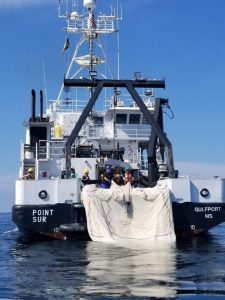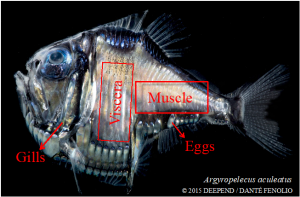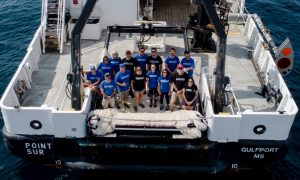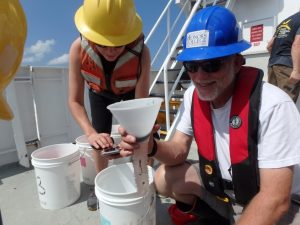Ten-Year Assessment Study Finds Increased Vulnerability of Deep Sea Fishes to Oil Exposure
– FEBRUARY 1, 2019
Scientists completed the first time-series study (2007-2016) of Gulf of Mexico deep-sea fishes and their exposure to polycyclic aromatic hydrocarbons (PAHs) following Deepwater Horizon. There was a 7- to 10-fold increase in PAH concentrations in fish muscle tissue in 2010−2011 compared to 2007, followed by a decrease in 2015-2016 to near levels measured in 2007. Water samples from summer 2010 measured at the depth of the subsurface oil plume (900−1300 m) had PAH concentrations up to 60.4 μg/L (compared to 0.1 μg/L background levels). Water samples from summer 2011 showed a reduction in PAHs concentrations, but they were still high (up to 48.2 μg/L) and at deeper depths (1200−2000 m) than 2010. Water samples from 2015 showed undetectable amounts of PAHs, indicating recovery after the oil spill. These results suggest an episodic contamination event in 2010 that continued through 2011 and a longer-term exposure to deep pelagic organisms than their shallower counterparts.
The researchers published their findings in Environmental Science & Technology: Decadal assessment of polycyclic aromatic hydrocarbons in mesopelagic fishes from the Gulf of Mexico reveals exposure to oil-derived sources.
The deep-pelagic environment is the largest component of the Gulf of Mexico with ~1500 fish species, half of which live at depths > 200 m and outnumbers all coastal fishes combined. There has been concern about how the Deepwater Horizon incident affected this environment, particularly because of diel vertical migration of mesopelagic fishes and the accumulation and resuspension of contaminants from sinking marine oil snow.
The team analyzed water data from 3,162 samples (provided by the NOAA Environmental Response Management Application website) and 315 deep-pelagic fish samples (collected during three earlier studies). Study author Isabel Romero explained a challenge they faced, “The samples collected 5-6 years after the oil spill had small sample sizes (tissues <0.1 g, dry weight), low concentrations (<10 ng/g), and matrix interference. To solve this challenge, we analyzed fish samples with gas chromatography coupled with tandem mass spectrometry and operated in multiple reaction monitoring mode (GC-MS/MS-MRM) using an Agilent 7680B-7010. This high ion selectivity method enabled us to identify and quantify compounds at very low concentrations with no interferences among different fish tissues (muscle, gills, guts/viscera, and unhatched eggs in ovaries).”
Two- to four-ring PAHs were predominate in water samples from 2010 and 2011 and then there was a shift afterward to more alkylated PAHs typical of weathered oil. This pattern was also evident in muscle tissue, with phenanthrene and C1−C2 alkyl homologues dominate in 2010-2011, followed by naphthalene and C1−C3 alkyl homologues. During 2015−2016, alkylated homologues of phenanthrene and naphthalene predominated, followed by 4-ring PAHs.
Romero explained the findings’ implications, “Our study found that oil residues stay in the environment longer than we thought and that long-term exposure to toxic chemicals may impact the new generation of deep-pelagic fishes. The relatively high PAH concentrations found in the unhatched eggs of mesopelagic fishes indicate that the next generations may be compromised (abundance may decrease over time). Awareness of this potential impact is important for environmental impact assessments.”
Romero suggested that future studies address knowledge gaps in temporal dynamics of toxic compounds related to fish growth, metabolism, and reproduction and to integrate PAH concentrations with population dynamics.
The study authors are Isabel C. Romero, Tracey Sutton, Brigid Carr, Ester Quintana-Rizzo, Steve W. Ross, David J. Hollander, and Joseph J. Torres.
Data are publicly available through the Gulf of Mexico Research Initiative Information and Data Cooperative (GRIIDC) at doi:10.7266/N7QZ28B4, doi:10.7266/N7XD1026, and doi:10.7266/N7W37T94
By Nilde Maggie Dannreuther. Contact maggied@ngi.msstate.edu with questions or comments.
************
This research was made possible in part by grants from the Gulf of Mexico Research Initiative (GoMRI) to the Center for Integrated Modeling and Analysis of Gulf Ecosystems (C-IMAGE), Center for Integrated Modeling and Analysis of Gulf Ecosystems II (C-IMAGE II), and the Deep-Pelagic Nekton Dynamics of the Gulf of Mexico (DEEPEND) consortium. Other support included the Department of the Interior U.S. Geological Survey under Cooperative (agreement no. 05HQAG0009, sub-agreement 05099HS004), the National Science Foundation (OCE-1047693), and the University of South Florida Office of Sponsored Research and the Florida Institute of Oceanography.
The Gulf of Mexico Research Initiative (GoMRI) is a 10-year independent research program established to study the effect, and the potential associated impact, of hydrocarbon releases on the environment and public health, as well as to develop improved spill mitigation, oil detection, characterization and remediation technologies. An independent and academic 20-member Research Board makes the funding and research direction decisions to ensure the intellectual quality, effectiveness and academic independence of the GoMRI research. All research data, findings and publications will be made publicly available. The program was established through a $500 million financial commitment from BP. For more information, visit https://gulfresearchinitiative.org/.
© Copyright 2010-2019 Gulf of Mexico Research Initiative (GoMRI) – All Rights Reserved. Redistribution is encouraged with acknowledgement to the Gulf of Mexico Research Initiative (GoMRI). Please credit images and/or videos as done in each article. Questions? Contact web-content editor Nilde “Maggie” Dannreuther, Northern Gulf Institute, Mississippi State University (maggied@ngi.msstate.edu).









